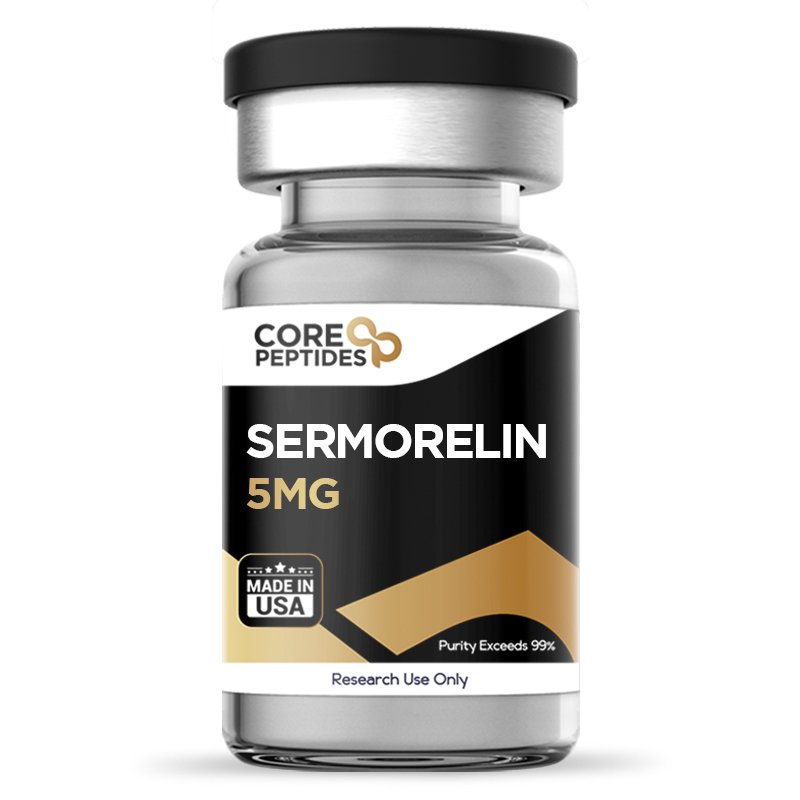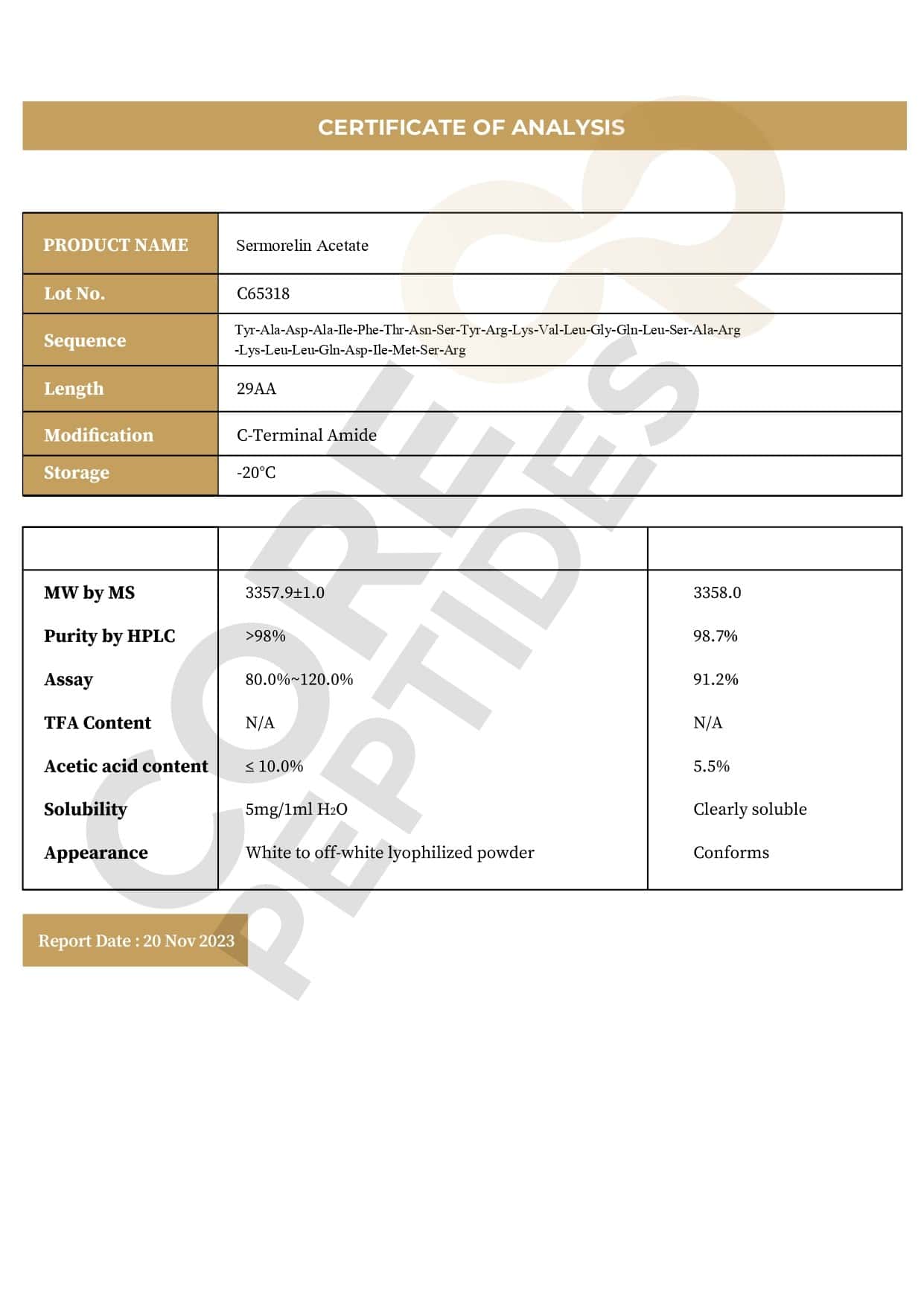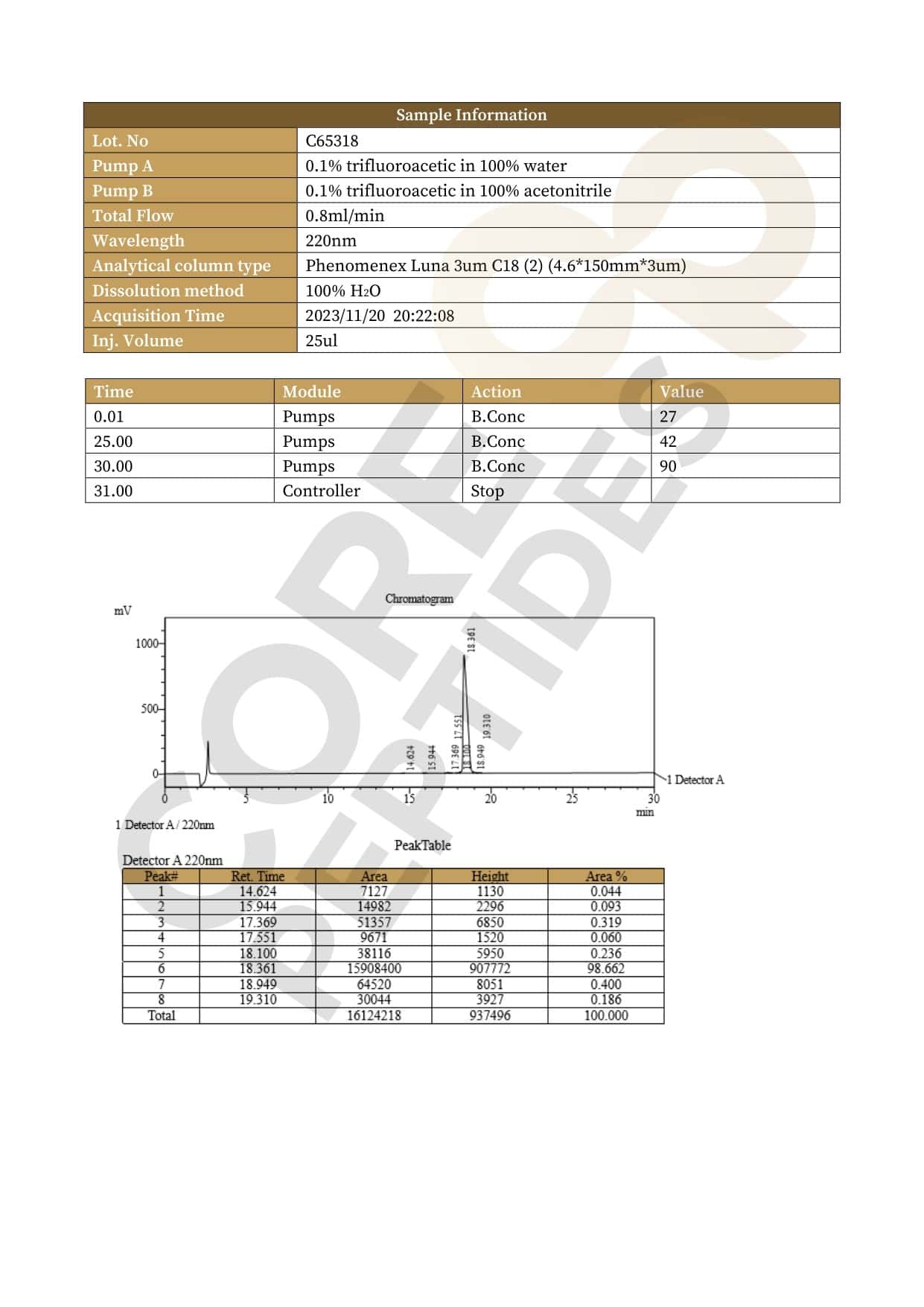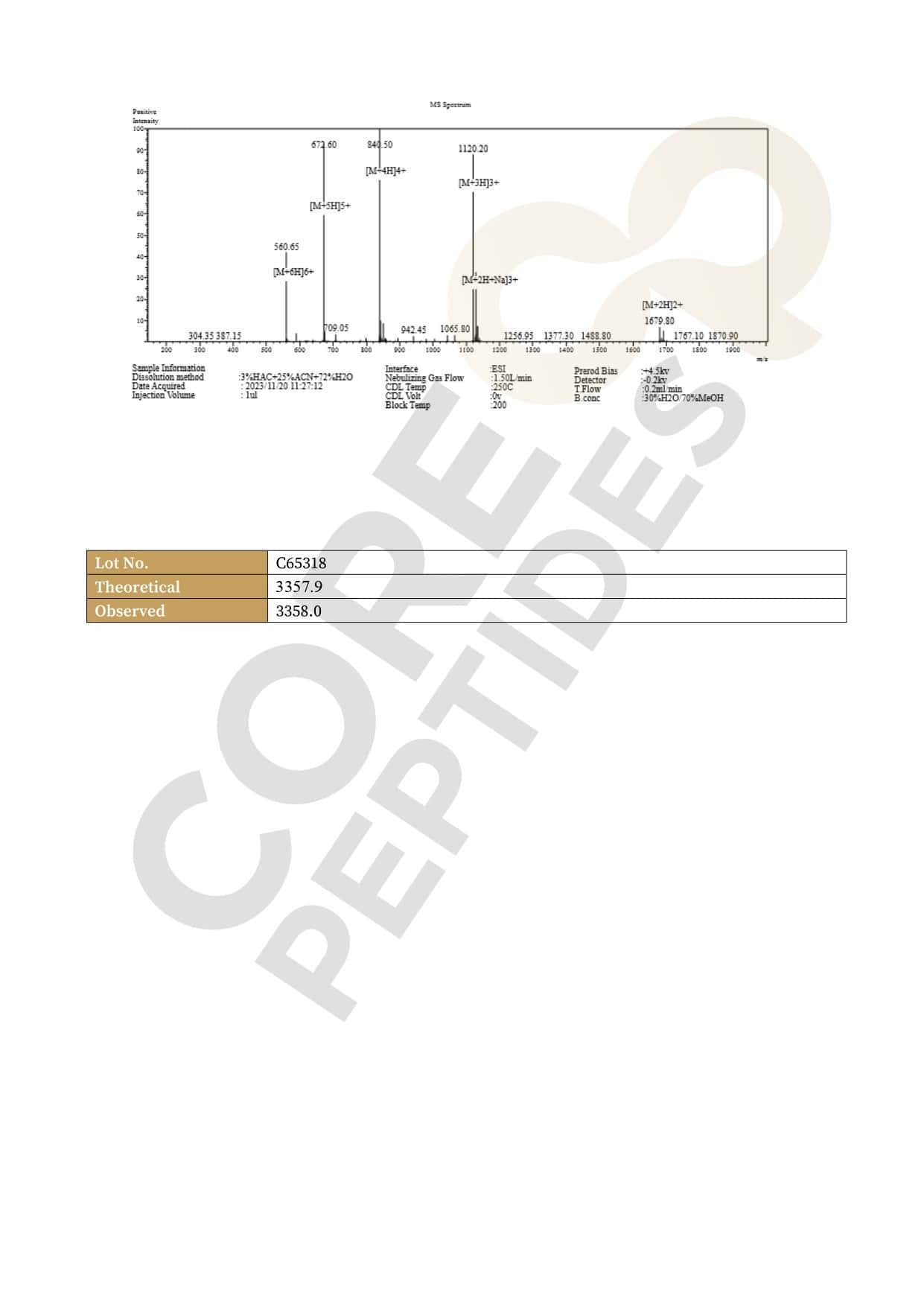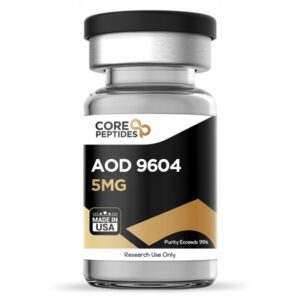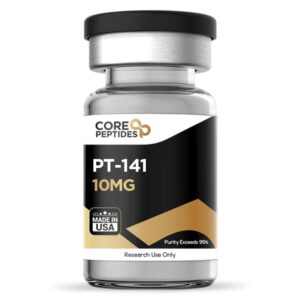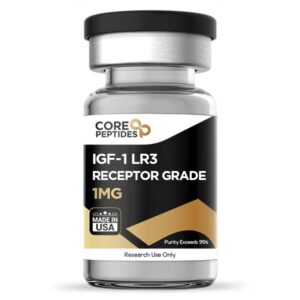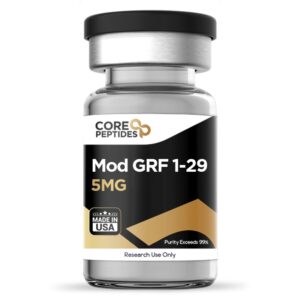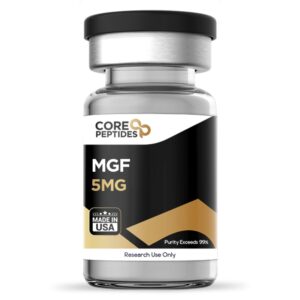Sermorelin (5mg)
$47.00
Size: 5mg
Contents: Sermorelin (5mg)
Form: Lyophilized powder
Purity: >99%
SKU: P-SERMORELIN-5
FREE Shipping on $200+ orders
FREE Bacteriostatic Water (30ml) on $200+ orders
Discount per Quantity
| Quantity | Discount | Price |
|---|---|---|
| 5 - 8 | 5% | $44.65 |
| 9 + | 10% | $42.30 |
Sermorelin Peptide
Sermorelin is a 29 amino acid peptide, the shortest synthetically developed peptide that exhibits potential to induce biological activity. Sermorelin is an exact match to the growth hormone-releasing hormone (GHRH).(2) Sermorelin polypeptide is an analog of the GHRH factor consisting of GHRH (1-29 acid)-amide. Due to this structure's presence, Sermorelin has been studied across multiple branches of scientific research involving growth hormone deficiency.(3)
It was in the early 1980s that the action of growth hormone fragment GHRF (1-29) amide was first explored. Several research studies were conducted on rats where exogenous GHRF (1-29) amide was introduced in conscious and anaesthetized rats. It was observed that the presence of GHRF appeared to stimulate the pituitary gland and promoted growth. Following this theory, growth hormone secretagogues (such as Sermorelin) became promising compounds for furthering research in growth hormone deficiencies.(4)
Overview
Sermorelin is a growth hormone analogue constituting first 29 amino acids out of the usual 44 amino acids found in growth hormone (HGH). Researchers posit that Sermorelin binds with the growth hormone receptors found on the pituitary gland and suggest further that the synthetic peptide may stimulate secretion of growth hormones.
The main potential of the peptide is that it may not induce any significant change in the levels of prolactin, insulin, cortisol, glucose, or thyroid hormones – which is further described in the research studies below.(6) Considered to be a growth hormone analogue, most of the potential actions of the peptide are suggested to be similar to that of the naturally occurring growth hormone.
Research and Clinical Studies
Sermorelin Peptide and Growth Hormone Deficiency
When Sermorelin was presented to young test subjects, researchers reported apparently positive results in subjects with idiopathic GH deficiency. Increased rate of growth and height velocity was observed within 12 months of consistent, continuous peptide presence. These elevated levels were reported to be sustained for an average of 36 months after continuous presence.(7)
Sermorelin Peptide and Lipodystrophy
Scientists carried out a controlled clinical study involving 31 HIV-positive subjects with lipodystrophy, to investigate the potential impact of Sermorelin.(8) All 31 subjects were divided into two groups, where one was presented with Sermorelin, and the other group with a placebo for 12 weeks. Following the study, it was suggested by the research team that growth hormone levels appeared significantly increased in Sermorelin subjects as compared to the ones given a placebo. Levels of insulin-like growth factor (IGF-1) had apparently increased – resulting in increased lean body mass in the peptide subjects. Abdominal visceral fat and ratio of trunk to lower extremity fat was reported by the researchers to be significantly reduced. There was no other reported change in the glucose or insulin levels.(8)
Sermorelin Peptide and Cognition
In the early 2000s, clinical research studies were conducted with 89 older subjects between 68 and 69 years of age, to explore the correlation (if any) between tapering growth hormone release and impaired cognition. Scientists consider that with increasing age, levels of growth hormone naturally decline, which result in reduced physiological functions, including cognition (i.e. ability to collect, process and recollect information). Following the introduction of Sermorelin, it was observed that there was an apparent improved performance in the Wechsler Adult Intelligence scale (WAIS) – i.e. improved IQ levels, picture arrangement tests and verbal tests - amongst the test subjects.(9)
Sermorelin Peptide and Tumor Cells
A clinical study was designed where 1,018 glioma subjects were presented with over 4,000 compounds each, and following each presentation, a DRS was determined for all compounds, for each subject. Following the results of the study, it appeared that the Sermorelin compound reportedly induced the most sensitivity in the test subjects. Upon analysis, it was suggested by the researchers that this may be so due to the potential of Sermorelin to block the tumor cell cycles, thereby possibly preventing tumor cell proliferation.(10)
Sermorelin Peptide and Hypogonadism
Initial research into the peptide suggested that Sermorelin might be impactful in increasing lean mass in test subjects. One study sought to explore if Sermorelin had potential in hypogonadism (which is considered to stem from additional fat mass). Test models were divided into two groups where one group was presented with Sermorelin followed by GHRH 1-40, with a one week interval between the two compounds, whereas the other group was given the same combination in reverse order. Following the study, it was reported by the researchers that for both the groups the Sermorelin appeared to stimulate the release of FSH and LH which might stimulate testosterone production.
This initial research spawned additional studies, including one clinical study that included 19 male subjects, 9 of whom were aged between 22 and 33 years of age and 10 were aged between 60 and 78 years of age. The more elderly subjects were presented with one of two concentrations of Sermorelin for a period of 28 days, with an interval of 14 days in between the two instances. Testosterone levels in the elderly subjects reportedly increased after the presentation of Sermorelin; however, it should be noted that the levels were not statistically significant. Furthermore, researchers suggested that elevated levels of growth hormones, possibly induced by Sermorelin presences, appeared to be at peak during the night time, for all test subjects, as compared during the day.(11)
Sermorelin peptide is available for research and laboratory purposes only. Please review and adhere to our Terms and Conditions before ordering.
References:
- Garcia JM, Merriam GR, Kargi AY. Growth Hormone in Aging. [Updated 2019 Oct 7]. In: Feingold KR, Anawalt B, Boyce A, et al., editors. Endotext [Internet]. South Dartmouth (MA): MDText.com, Inc.; 2000. https://www.ncbi.nlm.nih.gov/books/NBK279163/?report=reader
- Prakash, A, and K L Goa. “Sermorelin: a review of its use in the diagnosis and treatment of children with idiopathic growth hormone deficiency.” BioDrugs : clinical immunotherapeutics, biopharmaceuticals and gene therapy vol. 12,2 (1999): 139-57. https://pubmed.ncbi.nlm.nih.gov/18031173/
- National Center for Biotechnology Information. "PubChem Compound Summary for CID 16129620, Sermorelin" PubChem
- Clark, R G, and I C Robinson. “Growth induced by pulsatile infusion of an amidated fragment of human growth hormone releasing factor in normal and GHRF-deficient rats.” Nature vol. 314,6008 (1985): 281-3. https://pubmed.ncbi.nlm.nih.gov/2858818/
- Drugs at FDA: FDA Approved Drugs. https://www.accessdata.fda.gov/scripts/cder/daf/index.cfm?event=overview.process&ApplNo=020443
- Junichi I. et al, Growth hormone secretagogues: history, mechanism of action, and clinical development, JSCM Rapid Communications Vol. 3 Issue 1, 09 February 2020. https://onlinelibrary.wiley.com/doi/full/10.1002/rco2.9
- Prakash, A, and K L Goa. “Sermorelin: a review of its use in the diagnosis and treatment of children with idiopathic growth hormone deficiency.” BioDrugs : clinical immunotherapeutics, biopharmaceuticals and gene therapy vol. 12,2 (1999): 139-57. https://pubmed.ncbi.nlm.nih.gov/18031173/
- Koutkia, Polyxeni et al. “Growth hormone-releasing hormone in HIV-infected men with lipodystrophy: a randomized controlled trial.” JAMA vol. 292,2 (2004): 210-8. https://pubmed.ncbi.nlm.nih.gov/15249570/
- Vitiello, Michael V et al. “Growth hormone releasing hormone improves the cognition of healthy older adults.” Neurobiology of aging vol. 27,2 (2006): 318-23. https://pubmed.ncbi.nlm.nih.gov/16399214/
- Chang, Yuanhao et al. “A potentially effective drug for patients with recurrent glioma: sermorelin.” Annals of translational medicine vol. 9,5 (2021): 406. doi:10.21037/atm-20-6561. https://www.ncbi.nlm.nih.gov/pmc/articles/PMC8033379/
- Sinha, Deepankar K et al. “Beyond the androgen receptor: the role of growth hormone secretagogues in the modern management of body composition in hypogonadal males.” Translational andrology and urology vol. 9,Suppl 2 (2020): S149-S159. doi:10.21037/tau.2019.11.30. https://www.ncbi.nlm.nih.gov/pmc/articles/PMC7108996/

